Customer Understanding: Consumption in Tourism & Business Management
VerifiedAdded on 2023/06/12
|7
|1791
|328
Report
AI Summary
This report delves into understanding customer behavior within the tourism and business management sectors, emphasizing contemporary perspectives on consumption and individual decision-making processes. It examines the complexities of consumption beyond basic utilitarian value, highlighting its significance in the global economy. The report explores B2C and B2B models, the impact of individual versus group decision-making, and the importance of perceptual processes in understanding consumer choices. Social influences, financial status, age, and lifestyle factors are considered as key determinants of purchasing behavior. Furthermore, the report discusses future trends in consumer behavior, including increased health consciousness, digitalization, the role of social media, and the growing empowerment of travelers. The analysis concludes by underscoring the challenges faced by business leaders in navigating complex market conditions and the importance of a customer-centric approach.
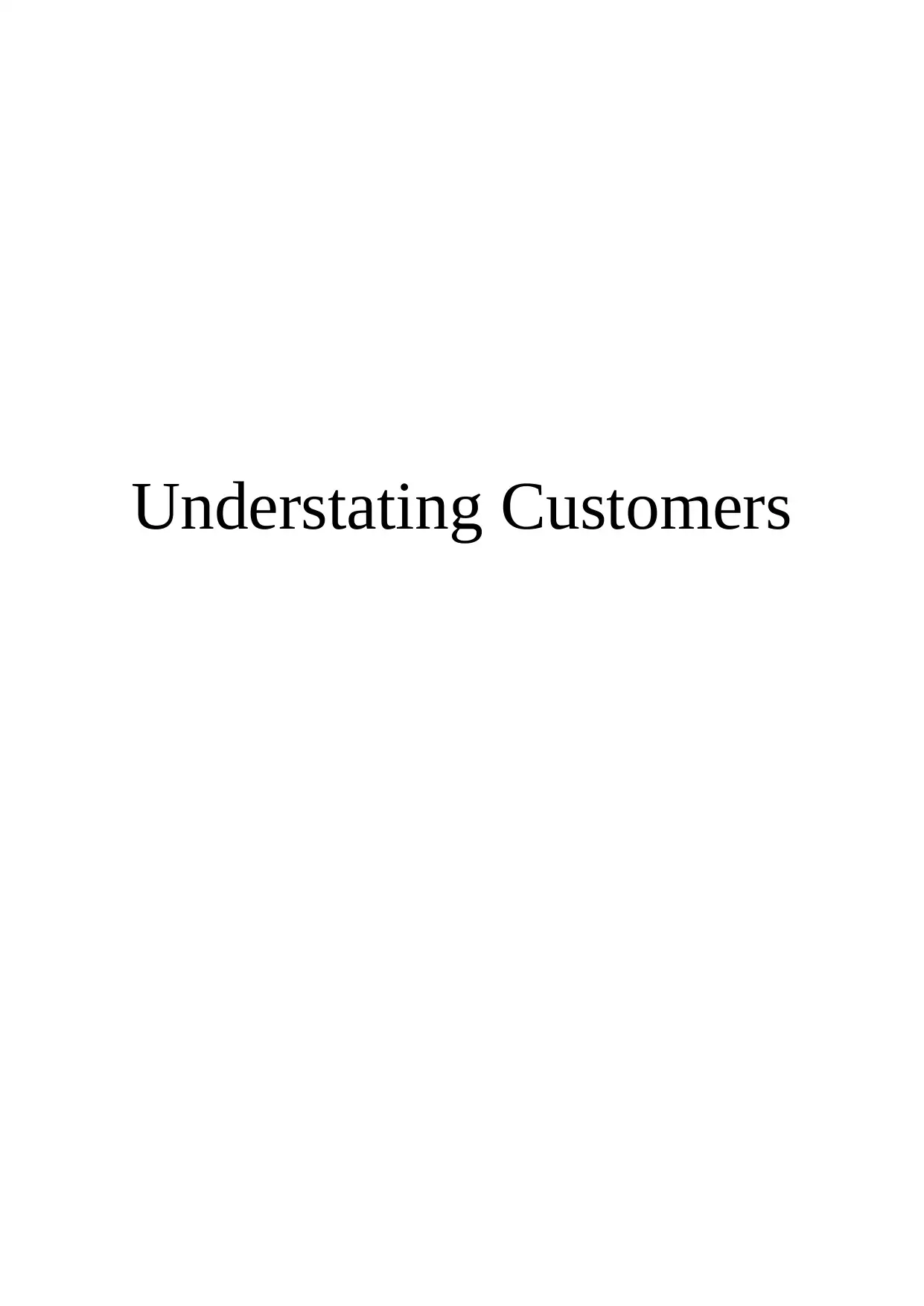
Understating Customers
Paraphrase This Document
Need a fresh take? Get an instant paraphrase of this document with our AI Paraphraser

Contents
Introduction................................................................................................................................3
Main Body..................................................................................................................................3
Contemporary Perspectives on consumption.........................................................................3
Individual Decision-Making and Involvement......................................................................4
Importance of Perceptual Processes in understanding individual consumers........................4
Future Trends in Consumer Behaviour..................................................................................5
Conclusion..................................................................................................................................6
References..................................................................................................................................7
Introduction................................................................................................................................3
Main Body..................................................................................................................................3
Contemporary Perspectives on consumption.........................................................................3
Individual Decision-Making and Involvement......................................................................4
Importance of Perceptual Processes in understanding individual consumers........................4
Future Trends in Consumer Behaviour..................................................................................5
Conclusion..................................................................................................................................6
References..................................................................................................................................7
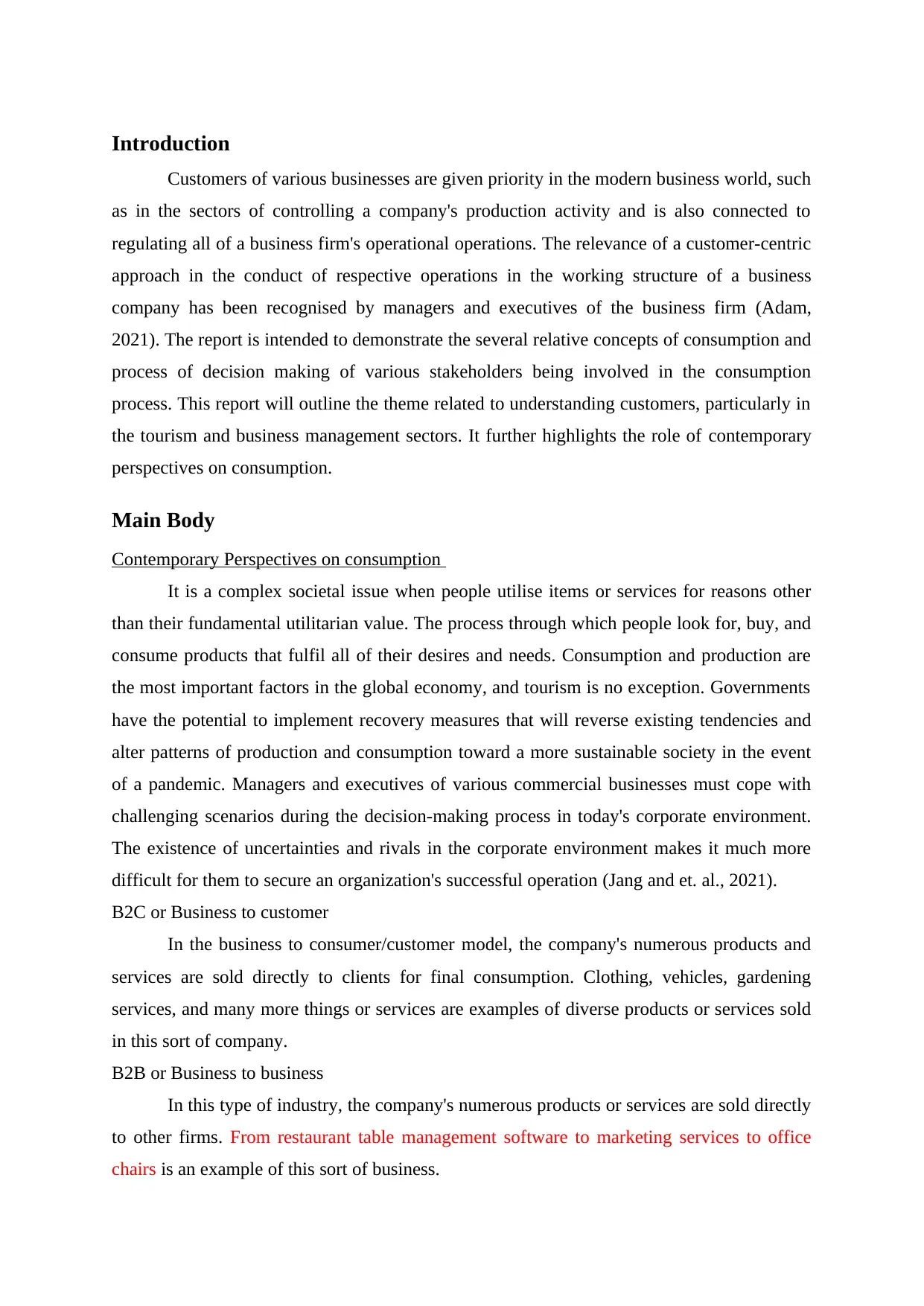
Introduction
Customers of various businesses are given priority in the modern business world, such
as in the sectors of controlling a company's production activity and is also connected to
regulating all of a business firm's operational operations. The relevance of a customer-centric
approach in the conduct of respective operations in the working structure of a business
company has been recognised by managers and executives of the business firm (Adam,
2021). The report is intended to demonstrate the several relative concepts of consumption and
process of decision making of various stakeholders being involved in the consumption
process. This report will outline the theme related to understanding customers, particularly in
the tourism and business management sectors. It further highlights the role of contemporary
perspectives on consumption.
Main Body
Contemporary Perspectives on consumption
It is a complex societal issue when people utilise items or services for reasons other
than their fundamental utilitarian value. The process through which people look for, buy, and
consume products that fulfil all of their desires and needs. Consumption and production are
the most important factors in the global economy, and tourism is no exception. Governments
have the potential to implement recovery measures that will reverse existing tendencies and
alter patterns of production and consumption toward a more sustainable society in the event
of a pandemic. Managers and executives of various commercial businesses must cope with
challenging scenarios during the decision-making process in today's corporate environment.
The existence of uncertainties and rivals in the corporate environment makes it much more
difficult for them to secure an organization's successful operation (Jang and et. al., 2021).
B2C or Business to customer
In the business to consumer/customer model, the company's numerous products and
services are sold directly to clients for final consumption. Clothing, vehicles, gardening
services, and many more things or services are examples of diverse products or services sold
in this sort of company.
B2B or Business to business
In this type of industry, the company's numerous products or services are sold directly
to other firms. From restaurant table management software to marketing services to office
chairs is an example of this sort of business.
Customers of various businesses are given priority in the modern business world, such
as in the sectors of controlling a company's production activity and is also connected to
regulating all of a business firm's operational operations. The relevance of a customer-centric
approach in the conduct of respective operations in the working structure of a business
company has been recognised by managers and executives of the business firm (Adam,
2021). The report is intended to demonstrate the several relative concepts of consumption and
process of decision making of various stakeholders being involved in the consumption
process. This report will outline the theme related to understanding customers, particularly in
the tourism and business management sectors. It further highlights the role of contemporary
perspectives on consumption.
Main Body
Contemporary Perspectives on consumption
It is a complex societal issue when people utilise items or services for reasons other
than their fundamental utilitarian value. The process through which people look for, buy, and
consume products that fulfil all of their desires and needs. Consumption and production are
the most important factors in the global economy, and tourism is no exception. Governments
have the potential to implement recovery measures that will reverse existing tendencies and
alter patterns of production and consumption toward a more sustainable society in the event
of a pandemic. Managers and executives of various commercial businesses must cope with
challenging scenarios during the decision-making process in today's corporate environment.
The existence of uncertainties and rivals in the corporate environment makes it much more
difficult for them to secure an organization's successful operation (Jang and et. al., 2021).
B2C or Business to customer
In the business to consumer/customer model, the company's numerous products and
services are sold directly to clients for final consumption. Clothing, vehicles, gardening
services, and many more things or services are examples of diverse products or services sold
in this sort of company.
B2B or Business to business
In this type of industry, the company's numerous products or services are sold directly
to other firms. From restaurant table management software to marketing services to office
chairs is an example of this sort of business.
⊘ This is a preview!⊘
Do you want full access?
Subscribe today to unlock all pages.

Trusted by 1+ million students worldwide

Individual Decision-Making and Involvement
The term Individual and group decision-making are two different types of decision-making.
Individual decision-making refers to decisions made only by an individual and when a group
of people gathers to discuss an issue, analyse alternatives, and pick the best option, they are
referred to as group decision making (Yang, Zhang and So, 2021). Making decisions is an
important process that managers must go through in every firm in the tourist industry. It is a
process in which decision makers must choose amongst many possibilities depending on their
beliefs. Every choice is made using a variety of decision procedures and models and
generally, people make judgments quickly. Making choices takes time when a group is ruled
by a few people. Individual decision-making also saves time, money, and energy because
people frequently reach quick and rational judgments. Group decision-making requires a
significant investment of time, money, and effort. (Le, Quy and Quy, 2021).
Organizational decision-making occurs at several levels and can range from the top to
the bottom. The distinction between top-down and bottom-up decision-making is that top-
down choices are made at the top of the organisation and then passed down the corporate
hierarchy to be executed (Sciortino and et. al., 2021). Bottom-up decision-making, on the
other hand, is accomplished by enabling middle and line managers to make decisions based
on the needs and conditions of their teams. Top-down decision making is seen in many
organisations in the areas of policy, strategic emphasis, and the direction in which the
organisation must proceed, whereas bottom-up decision making is seen in the areas of day-to-
day operations (Seeler and et. al., 2021).
Importance of Perceptual Processes in understanding individual consumers
Customers play various roles in purchasing goods or services and consumer purchasing
decisions are influenced by a variety of social influences. There are various consumers in the
society which are explained below-
The way a person interacts with others in society is referred to as their lifestyle, which
is one of the social processes. Some people place a great value on wearing branded
clothing, while others don't bother about how they look. The style, attitude,
perspective, social contacts, and immediate environment all impact a person's
lifestyle.
Another consideration is one's financial status, since purchasing power is directly
related to monthly wage. Individuals with a greater income would spend their money
on more costly and high-quality things than those with a lower or moderate income,
The term Individual and group decision-making are two different types of decision-making.
Individual decision-making refers to decisions made only by an individual and when a group
of people gathers to discuss an issue, analyse alternatives, and pick the best option, they are
referred to as group decision making (Yang, Zhang and So, 2021). Making decisions is an
important process that managers must go through in every firm in the tourist industry. It is a
process in which decision makers must choose amongst many possibilities depending on their
beliefs. Every choice is made using a variety of decision procedures and models and
generally, people make judgments quickly. Making choices takes time when a group is ruled
by a few people. Individual decision-making also saves time, money, and energy because
people frequently reach quick and rational judgments. Group decision-making requires a
significant investment of time, money, and effort. (Le, Quy and Quy, 2021).
Organizational decision-making occurs at several levels and can range from the top to
the bottom. The distinction between top-down and bottom-up decision-making is that top-
down choices are made at the top of the organisation and then passed down the corporate
hierarchy to be executed (Sciortino and et. al., 2021). Bottom-up decision-making, on the
other hand, is accomplished by enabling middle and line managers to make decisions based
on the needs and conditions of their teams. Top-down decision making is seen in many
organisations in the areas of policy, strategic emphasis, and the direction in which the
organisation must proceed, whereas bottom-up decision making is seen in the areas of day-to-
day operations (Seeler and et. al., 2021).
Importance of Perceptual Processes in understanding individual consumers
Customers play various roles in purchasing goods or services and consumer purchasing
decisions are influenced by a variety of social influences. There are various consumers in the
society which are explained below-
The way a person interacts with others in society is referred to as their lifestyle, which
is one of the social processes. Some people place a great value on wearing branded
clothing, while others don't bother about how they look. The style, attitude,
perspective, social contacts, and immediate environment all impact a person's
lifestyle.
Another consideration is one's financial status, since purchasing power is directly
related to monthly wage. Individuals with a greater income would spend their money
on more costly and high-quality things than those with a lower or moderate income,
Paraphrase This Document
Need a fresh take? Get an instant paraphrase of this document with our AI Paraphraser
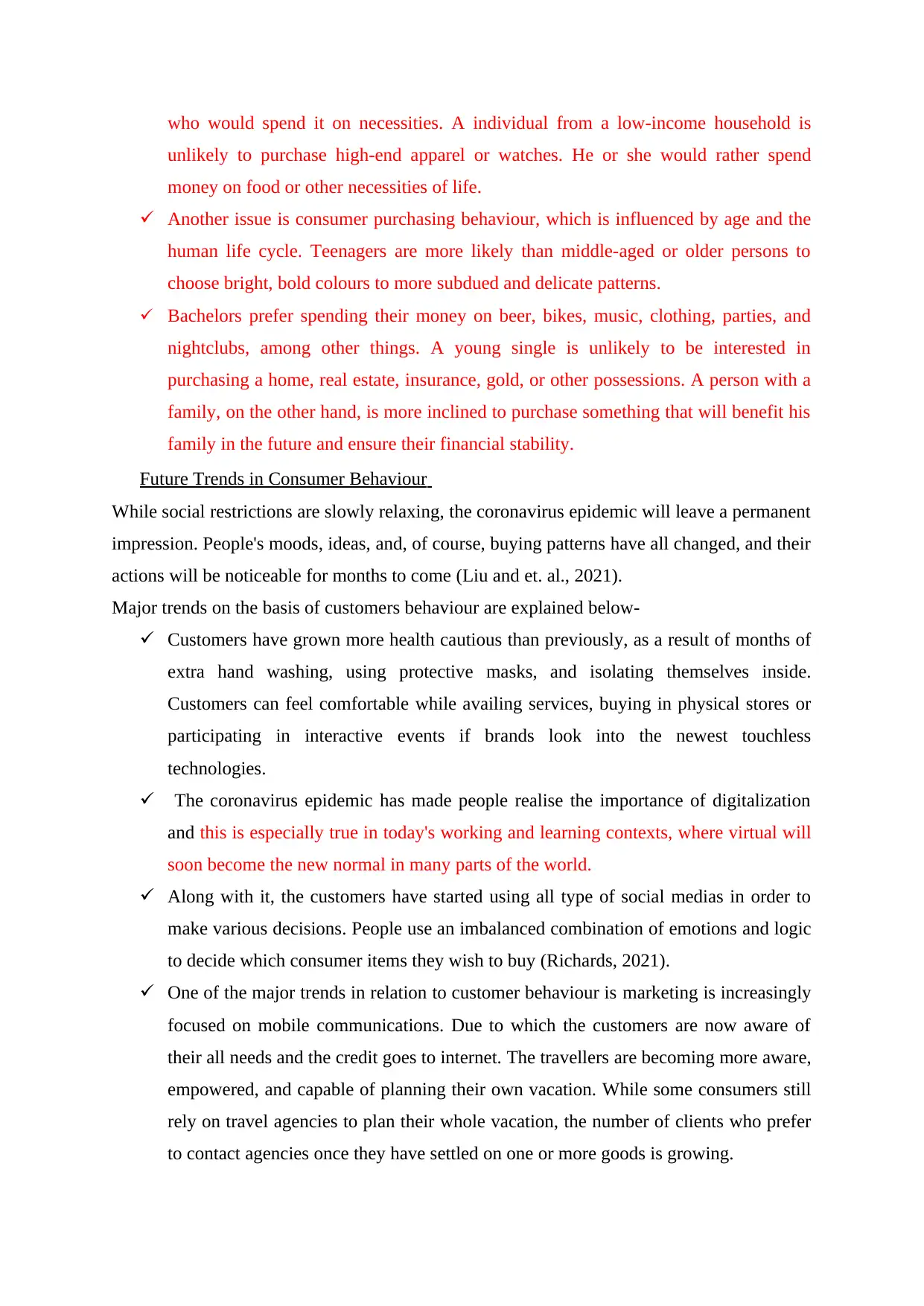
who would spend it on necessities. A individual from a low-income household is
unlikely to purchase high-end apparel or watches. He or she would rather spend
money on food or other necessities of life.
Another issue is consumer purchasing behaviour, which is influenced by age and the
human life cycle. Teenagers are more likely than middle-aged or older persons to
choose bright, bold colours to more subdued and delicate patterns.
Bachelors prefer spending their money on beer, bikes, music, clothing, parties, and
nightclubs, among other things. A young single is unlikely to be interested in
purchasing a home, real estate, insurance, gold, or other possessions. A person with a
family, on the other hand, is more inclined to purchase something that will benefit his
family in the future and ensure their financial stability.
Future Trends in Consumer Behaviour
While social restrictions are slowly relaxing, the coronavirus epidemic will leave a permanent
impression. People's moods, ideas, and, of course, buying patterns have all changed, and their
actions will be noticeable for months to come (Liu and et. al., 2021).
Major trends on the basis of customers behaviour are explained below-
Customers have grown more health cautious than previously, as a result of months of
extra hand washing, using protective masks, and isolating themselves inside.
Customers can feel comfortable while availing services, buying in physical stores or
participating in interactive events if brands look into the newest touchless
technologies.
The coronavirus epidemic has made people realise the importance of digitalization
and this is especially true in today's working and learning contexts, where virtual will
soon become the new normal in many parts of the world.
Along with it, the customers have started using all type of social medias in order to
make various decisions. People use an imbalanced combination of emotions and logic
to decide which consumer items they wish to buy (Richards, 2021).
One of the major trends in relation to customer behaviour is marketing is increasingly
focused on mobile communications. Due to which the customers are now aware of
their all needs and the credit goes to internet. The travellers are becoming more aware,
empowered, and capable of planning their own vacation. While some consumers still
rely on travel agencies to plan their whole vacation, the number of clients who prefer
to contact agencies once they have settled on one or more goods is growing.
unlikely to purchase high-end apparel or watches. He or she would rather spend
money on food or other necessities of life.
Another issue is consumer purchasing behaviour, which is influenced by age and the
human life cycle. Teenagers are more likely than middle-aged or older persons to
choose bright, bold colours to more subdued and delicate patterns.
Bachelors prefer spending their money on beer, bikes, music, clothing, parties, and
nightclubs, among other things. A young single is unlikely to be interested in
purchasing a home, real estate, insurance, gold, or other possessions. A person with a
family, on the other hand, is more inclined to purchase something that will benefit his
family in the future and ensure their financial stability.
Future Trends in Consumer Behaviour
While social restrictions are slowly relaxing, the coronavirus epidemic will leave a permanent
impression. People's moods, ideas, and, of course, buying patterns have all changed, and their
actions will be noticeable for months to come (Liu and et. al., 2021).
Major trends on the basis of customers behaviour are explained below-
Customers have grown more health cautious than previously, as a result of months of
extra hand washing, using protective masks, and isolating themselves inside.
Customers can feel comfortable while availing services, buying in physical stores or
participating in interactive events if brands look into the newest touchless
technologies.
The coronavirus epidemic has made people realise the importance of digitalization
and this is especially true in today's working and learning contexts, where virtual will
soon become the new normal in many parts of the world.
Along with it, the customers have started using all type of social medias in order to
make various decisions. People use an imbalanced combination of emotions and logic
to decide which consumer items they wish to buy (Richards, 2021).
One of the major trends in relation to customer behaviour is marketing is increasingly
focused on mobile communications. Due to which the customers are now aware of
their all needs and the credit goes to internet. The travellers are becoming more aware,
empowered, and capable of planning their own vacation. While some consumers still
rely on travel agencies to plan their whole vacation, the number of clients who prefer
to contact agencies once they have settled on one or more goods is growing.
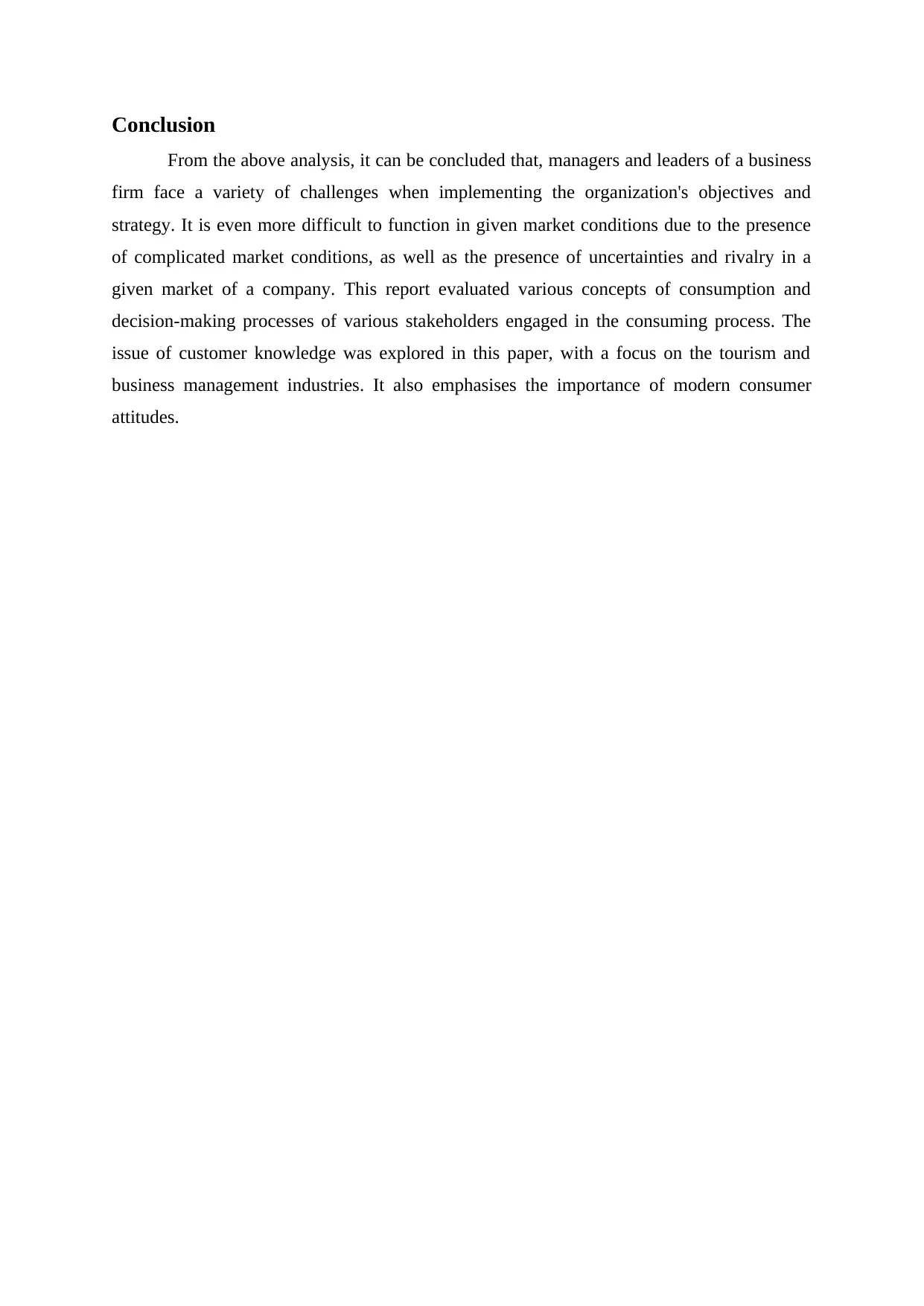
Conclusion
From the above analysis, it can be concluded that, managers and leaders of a business
firm face a variety of challenges when implementing the organization's objectives and
strategy. It is even more difficult to function in given market conditions due to the presence
of complicated market conditions, as well as the presence of uncertainties and rivalry in a
given market of a company. This report evaluated various concepts of consumption and
decision-making processes of various stakeholders engaged in the consuming process. The
issue of customer knowledge was explored in this paper, with a focus on the tourism and
business management industries. It also emphasises the importance of modern consumer
attitudes.
From the above analysis, it can be concluded that, managers and leaders of a business
firm face a variety of challenges when implementing the organization's objectives and
strategy. It is even more difficult to function in given market conditions due to the presence
of complicated market conditions, as well as the presence of uncertainties and rivalry in a
given market of a company. This report evaluated various concepts of consumption and
decision-making processes of various stakeholders engaged in the consuming process. The
issue of customer knowledge was explored in this paper, with a focus on the tourism and
business management industries. It also emphasises the importance of modern consumer
attitudes.
⊘ This is a preview!⊘
Do you want full access?
Subscribe today to unlock all pages.

Trusted by 1+ million students worldwide
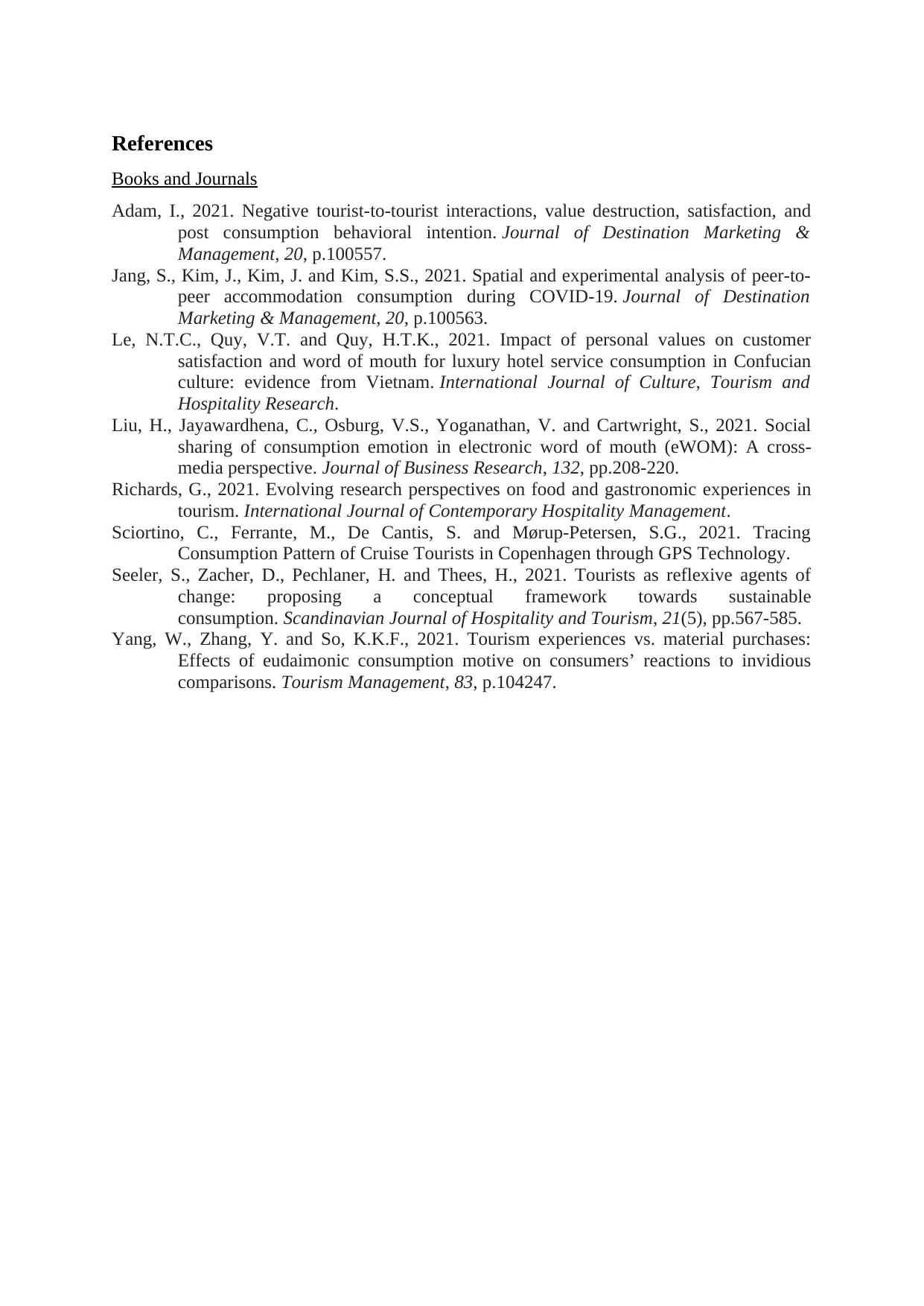
References
Books and Journals
Adam, I., 2021. Negative tourist-to-tourist interactions, value destruction, satisfaction, and
post consumption behavioral intention. Journal of Destination Marketing &
Management, 20, p.100557.
Jang, S., Kim, J., Kim, J. and Kim, S.S., 2021. Spatial and experimental analysis of peer-to-
peer accommodation consumption during COVID-19. Journal of Destination
Marketing & Management, 20, p.100563.
Le, N.T.C., Quy, V.T. and Quy, H.T.K., 2021. Impact of personal values on customer
satisfaction and word of mouth for luxury hotel service consumption in Confucian
culture: evidence from Vietnam. International Journal of Culture, Tourism and
Hospitality Research.
Liu, H., Jayawardhena, C., Osburg, V.S., Yoganathan, V. and Cartwright, S., 2021. Social
sharing of consumption emotion in electronic word of mouth (eWOM): A cross-
media perspective. Journal of Business Research, 132, pp.208-220.
Richards, G., 2021. Evolving research perspectives on food and gastronomic experiences in
tourism. International Journal of Contemporary Hospitality Management.
Sciortino, C., Ferrante, M., De Cantis, S. and Mørup-Petersen, S.G., 2021. Tracing
Consumption Pattern of Cruise Tourists in Copenhagen through GPS Technology.
Seeler, S., Zacher, D., Pechlaner, H. and Thees, H., 2021. Tourists as reflexive agents of
change: proposing a conceptual framework towards sustainable
consumption. Scandinavian Journal of Hospitality and Tourism, 21(5), pp.567-585.
Yang, W., Zhang, Y. and So, K.K.F., 2021. Tourism experiences vs. material purchases:
Effects of eudaimonic consumption motive on consumers’ reactions to invidious
comparisons. Tourism Management, 83, p.104247.
Books and Journals
Adam, I., 2021. Negative tourist-to-tourist interactions, value destruction, satisfaction, and
post consumption behavioral intention. Journal of Destination Marketing &
Management, 20, p.100557.
Jang, S., Kim, J., Kim, J. and Kim, S.S., 2021. Spatial and experimental analysis of peer-to-
peer accommodation consumption during COVID-19. Journal of Destination
Marketing & Management, 20, p.100563.
Le, N.T.C., Quy, V.T. and Quy, H.T.K., 2021. Impact of personal values on customer
satisfaction and word of mouth for luxury hotel service consumption in Confucian
culture: evidence from Vietnam. International Journal of Culture, Tourism and
Hospitality Research.
Liu, H., Jayawardhena, C., Osburg, V.S., Yoganathan, V. and Cartwright, S., 2021. Social
sharing of consumption emotion in electronic word of mouth (eWOM): A cross-
media perspective. Journal of Business Research, 132, pp.208-220.
Richards, G., 2021. Evolving research perspectives on food and gastronomic experiences in
tourism. International Journal of Contemporary Hospitality Management.
Sciortino, C., Ferrante, M., De Cantis, S. and Mørup-Petersen, S.G., 2021. Tracing
Consumption Pattern of Cruise Tourists in Copenhagen through GPS Technology.
Seeler, S., Zacher, D., Pechlaner, H. and Thees, H., 2021. Tourists as reflexive agents of
change: proposing a conceptual framework towards sustainable
consumption. Scandinavian Journal of Hospitality and Tourism, 21(5), pp.567-585.
Yang, W., Zhang, Y. and So, K.K.F., 2021. Tourism experiences vs. material purchases:
Effects of eudaimonic consumption motive on consumers’ reactions to invidious
comparisons. Tourism Management, 83, p.104247.
1 out of 7
Related Documents
Your All-in-One AI-Powered Toolkit for Academic Success.
+13062052269
info@desklib.com
Available 24*7 on WhatsApp / Email
![[object Object]](/_next/static/media/star-bottom.7253800d.svg)
Unlock your academic potential
Copyright © 2020–2025 A2Z Services. All Rights Reserved. Developed and managed by ZUCOL.

